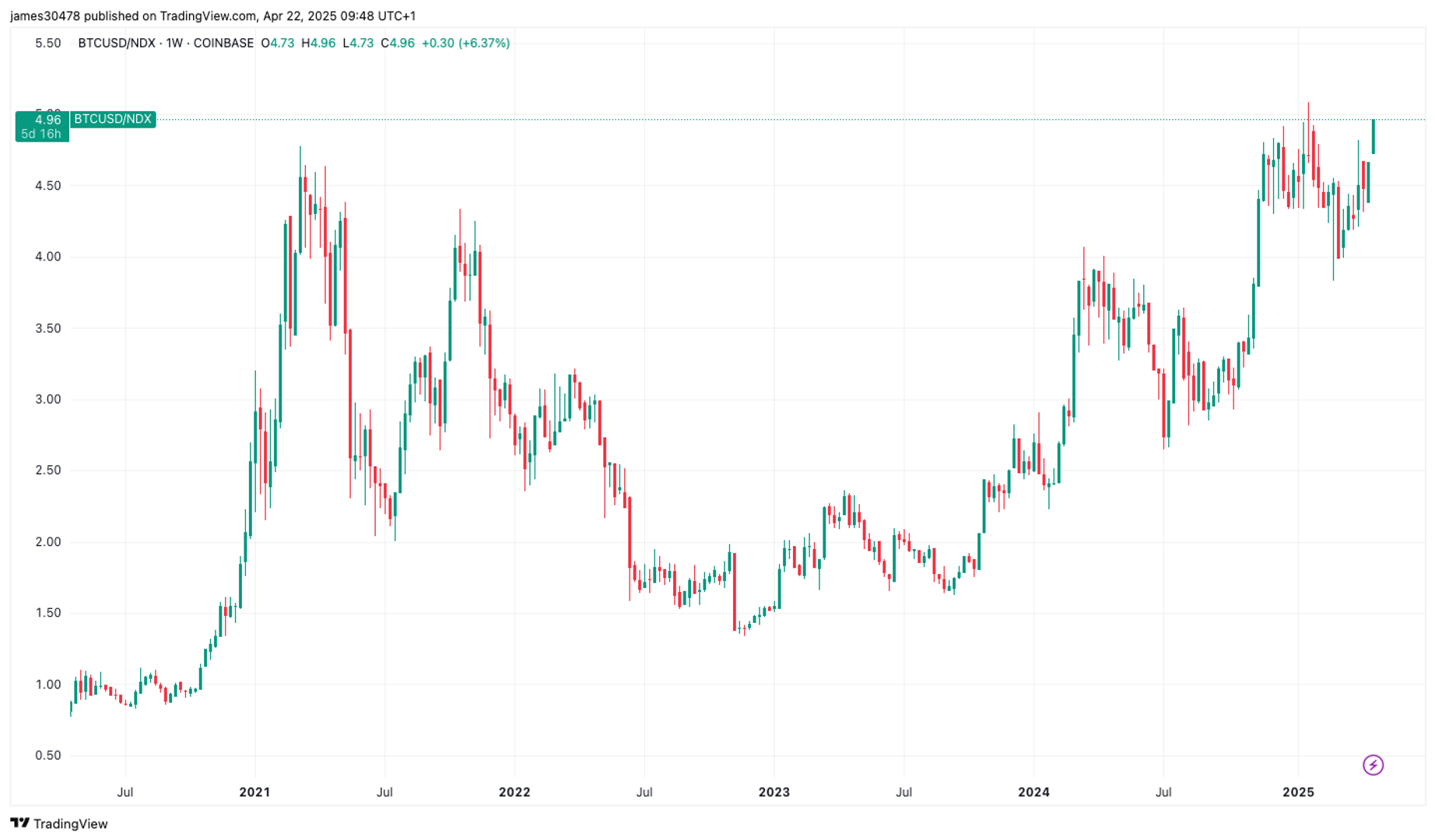Uncategorized
Out With the “Altcoin,” in With the Asset Class

Following the U.S. presidential election, crypto’s headwinds have seemingly dissipated. Since early November bitcoin has reached $100K amid regulatory wins such as the nomination of crypto-friendly Paul Atkins to replace Gary Gensler as SEC chair, the naming of crypto advocate David Sacks as the incoming White House “AI and Crypto Czar,” and Congressman French Hill’s appointment to head the House Financial Services Committee. With election season coming to a crypto-favorable close in 2024, some are forecasting “altcoin” season, a period of outperformance for non-BTC crypto assets, to continue in 2025 — but is this the right way to characterize digital assets broadly?
You’re reading Crypto Long & Short, our weekly newsletter featuring insights, news and analysis for the professional investor. Sign up here to get it in your inbox every Wednesday.
Market commentators sometimes hastily sort the crypto economy into two oversimplified groups: 1) bitcoin (and now for some, ether) and 2) alternative or “alt” coins. In the early innings of digital assets, this dual categorization made sense as bitcoin was pioneering the use of blockchain technology and other use cases were still finding their footing. Nearly 16 years since bitcoin’s inception, an explosion of crypto innovation and sector-specific applications has pushed blockchain assets beyond the binary classification of bitcoin and “everything else.” Investors must now treat crypto as a diverse multi-sector asset class.
Putting the constituents of the digital asset class in perspective
The “altcoin” moniker may give the impression that digital assets other than bitcoin lack in size and industry-specific purpose compared to components of other asset classes such as equity markets. Figure 1 below compares the market caps of similarly sized constituents of the S&P500 Index to those of prominent crypto assets ex-BTC, and shows similarities between these asset classes not only in terms of component size, but also in terms of sector diversification:
Figure 1: Market Caps of Top 25 (ex-BTC) Crypto Assets vs. S&P 500 Constituents Smaller than ETH

Not only do the stocks of certain well-known companies highlighted above resemble the top 25 crypto assets in size (ex: Solana has a market cap similar to that of UPS), but both asset classes also span a variety of industries within their respective markets. While the number of digital assets shown above is relatively sparse compared to the number of stocks, these crypto assets alongside the market’s new and innovative crypto projects are likely to continue expanding the size and breadth of the asset class even further over time.
Constructing diversified digital asset portfolios for the long-run
Taking a binary “bitcoin vs. alts” approach to digital asset investing may forgo portfolio construction benefits both within crypto investments and across your overall asset allocation. Obtaining thoughtfully constructed, diversified, and intentional exposure to all crypto sectors and use cases helps defray the risks of asset concentration, ensures your portfolio is exposed to the full value proposition of the asset class, and provides a larger number of return sources within your broader asset allocation. Given the fast-changing, innovative nature of the digital asset landscape, it is crucial to construct crypto allocations that can adapt alongside the breadth of the asset class. This can be accomplished by adopting a process to choose the universe of assets to include in your portfolio, adjusting this universe over time, and allocating sensibly to these assets via either passive or active management. Embracing the broader crypto economy as an asset class within your investment portfolio means allocating to digital assets via strategies that are built for the long-term.
Conclusions for an evolving asset class
Focusing on bitcoin vs. “everything else” may obscure the already meaningful and fast-growing footprint of many crypto assets and could cause investors to miss out on longer-term portfolio benefits associated with comprehensive investment within the asset class.
Uncategorized
Bitcoin Closing In on Historic Breakout vs Nasdaq

Bitcoin (BTC) is on the cusp of breaking out relative to the Nasdaq 100 Composite, with the current BTC/Nasdaq ratio sitting at 4.96. This means it now takes nearly five Nasdaq units to match the value of one bitcoin. The previous record of 5.08 was set in January 2025, when bitcoin hit its all-time high of over $109,000.
Historically, each market cycle has seen the ratio reach new highs—2017, 2021, and now 2025—highlighting bitcoin’s continued outperformance against the Nasdaq.
Across multiple timeframes, bitcoin is increasingly diverging from U.S. tech stocks. Year-to-date, bitcoin is down just 6%, compared to the Nasdaq’s 15% decline. Since Donald Trump’s election victory in November 2024, bitcoin has rallied 30%, while the Nasdaq has fallen 12%.
When measured against the «Magnificent Seven» mega-cap tech stocks, bitcoin remains around 20% below its all-time high from February this year. This indicates that while bitcoin has shown strength, the top tech names are holding up better than the broader Nasdaq Composite.
Strategy (MSTR), a well-known proxy for bitcoin exposure, is also holding up better than the U.S tech stocks. Since joining the QQQ ETF on Dec. 23, MSTR is down 11%, while the ETF itself has dropped over 16%. The divergence has become more pronounced in 2025: MSTR is up 6% year-to-date, compared to QQQ’s 15% decline.
Uncategorized
Bitcoin Runs Into Resistance Cluster Above $88K. What Next?

This is a daily technical analysis by CoinDesk analyst and Chartered Market Technician Omkar Godbole.
Bitcoin’s (BTC) bullish advance has encountered a resistance zone above $88,000, marked by crucial levels that could make or break the ongoing recovery rally.
The resistance cluster’s first and perhaps most critical level is the 200-day simple moving average (SMA) at $88,356. The SMA is widely regarded as a key indicator of long-term momentum. Early this month, Coinbase institutional analysts called the downside break of the 200-day SMA in March a sign of the onset of a potential crypto winter.
So, a fresh move above the 200-day SMA could be taken to represent a renewed bullish shift in momentum.
Such a move would trigger a dual breakout, as the Ichimoku cloud’s upper end is located close to the 200-day SMA. A move above the Ichimoku cloud is also said to reflect a bullish shift in momentum.
Developed by a Japanese journalist in the 1960s, the Ichimoku cloud is a technical analysis indicator that offers a comprehensive view of market momentum, support, and resistance levels. The indicator comprises five lines: Leading Span A, Leading Span B, Conversion Line or Tenkan-Sen (T), Base Line or Kijun-Sen (K) and a lagging closing price line. The difference between Leading Span A and B forms the Ichimoku Cloud.
The third and final level forming the resistance cluster is the high of $88,804 on March 24, from where the market turned lower and fell back to $75,000.

A make-or-break resistance zone?
Behavioural aspects of trading come into play when an asset approaches a resistance zone, especially at key levels like the 200-day SMA and the Ichimoku cloud.
Prospect theory suggests that people are typically risk-averse with respect to gains and risk-seeking with respect to losses, known as the “reflection effect.» So, as traders, people tend to be risk-averse while locking in profits and keep losing trades open.
This tendency is amplified when an asset encounters a significant resistance zone. Traders who entered the bitcoin market around $75K, anticipating a rebound, may feel pressured to take profits as the price approaches this resistance. Such selling could, in turn, slow the price ascent or even trigger a new downturn.
Conversely, if bitcoin successfully breaks through the resistance zone, the fear of missing out could prompt more traders to make bullish bets, further fueling bullish momentum and pushing the price higher.
Uncategorized
Bithumb to Split in Two as Crypto Exchange Inches Toward South Korean IPO

Bithumb plans to split its core crypto exchange business from other activities as it reorganizes in preparation for an initial public offering (IPO).
The Seoul-based company will split in two, with Bithumb Korea focusing solely on operating the core crypto exchange business. Bithumb Korea will be the entity seeking a public listing, local media reported, citing the country’s corporate registry.
The other unit, a newly created company called Bithumb A, will oversee venture investments, asset management and new business initiatives. The restructuring is set to take effect on July 31.
Bithumb A will consolidate the exchange’s investment arms, including Bithumb Partners, which has shifted from NFT and metaverse projects to financial product investments such as equities, bonds and convertible bonds. According to local media, Bithumb is in talks with licensed entities to offer these services in the country.
Bithumb Investment, which manages equity stakes and strategic partnerships with external companies, will also fall under Bithumb A’s oversight.
Last year Bithumb was said to be considering a NASDAQ listing, but now its plans have shifted to a listing on South Korea’s Kosdaq first, with a U.S. listing as a secondary objective.
Bithumb posted an operating profit of 130.8 billion won ($95 million) in 2024, reversing a 149 billion-won loss from the previous year, local media reported.
-

 Fashion6 месяцев ago
Fashion6 месяцев agoThese \’90s fashion trends are making a comeback in 2017
-

 Entertainment6 месяцев ago
Entertainment6 месяцев agoThe final 6 \’Game of Thrones\’ episodes might feel like a full season
-

 Fashion6 месяцев ago
Fashion6 месяцев agoAccording to Dior Couture, this taboo fashion accessory is back
-

 Entertainment6 месяцев ago
Entertainment6 месяцев agoThe old and New Edition cast comes together to perform
-

 Sports6 месяцев ago
Sports6 месяцев agoPhillies\’ Aaron Altherr makes mind-boggling barehanded play
-

 Business6 месяцев ago
Business6 месяцев agoUber and Lyft are finally available in all of New York State
-

 Entertainment6 месяцев ago
Entertainment6 месяцев agoDisney\’s live-action Aladdin finally finds its stars
-

 Sports6 месяцев ago
Sports6 месяцев agoSteph Curry finally got the contract he deserves from the Warriors





